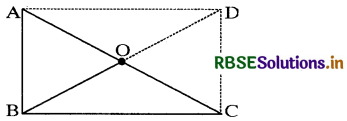RBSE Solutions for Class 8 Maths Chapter 3 Understanding Quadrilaterals Ex 3.4
Rajasthan Board RBSE Solutions for Class 8 Maths Chapter 3 Understanding Quadrilaterals Ex 3.4 Textbook Exercise Questions and Answers.
RBSE Class 8 Maths Solutions Chapter 3 Understanding Quadrilaterals Ex 3.4
Question 1.
State whether True or False.
(a) All rectangles are squares
Answer:
False
(b) All rhombuses are parallelograms
Answer:
True
(c) All squares are rhombuses and also rectangles
Answer:
True
(d) All squares are not parallelograms
Answer:
False
(e) All kites are rhombuses
Answer:
False
(f) All rhombuses are kites
Answer:
True
(g) All parallelograms are trapeziums
Answer:
True
(h) All squares are trapeziums.
Answer:
True.
Question 2.
Identify all the quadrilaterals that have.
(a) four sides of equal length
(b) four right angles
Answer:
(a) The quadrilateral having four sides of equal length is either a square or a rhombus.
(b) The quadrilaterals having four right angles in either a square or a rectangle.
Question 3.
Explain how a square is.
(i) a quadrilateral
Answer:
A square is four sided, so it is a quadrilateral.
(ii) a parallelogram
Answer:
A square has its opposite sides parallel so it is parallelogram.
(iii) a rhombus
Answer:
A square is a parallelogram with all the four sides equal, so it is a rhombus.
(iv) a rectangle
Answer:
A square is a parallelogram with each angle right angle, so it is a rectangle.
Question 4.
Name the quadrilaterals whose diagonals.
(i) bisect each other
Answer:
The quadrilaterals whose diagonals bisect each other can be a parallelogram or a rhombus or a square or a rectangle.
(ii) are perpendicular bisectors of each other
Answer:
The quadrilaterals whose diagonals are perpendicular bisectors of each other can be a rhombus or a square.
(iii) are equal.
Answer:
The quadrilaterals whose diagonals are equal to be a square or a rectangle.
Question 5.
Explain why a rectangle is a convex quadrilateral.
Answer:
Since the measure of each angle of a rectangle is less than 180° and also both the diagonals of a rectangle lie in its interior, so a rectangle is a convex quadrilateral.
Question 6.
ABC is a right-angled triangle and O is the mid point of the side opposite to the right angle. Explain why O is equidistant from A, B and C. (The dotted lines are drawn additionally to help you).

Answer:
We extend BO to D such that BO = OD. Then we join AD and DC. Now ABCD is a rectangle. In the rectangle ABCD, its diagonals AC and BD are equal and bisect each other at O.
∴ OA = OC and OB = OD
But AC = BD
Therefore, OA = OB = OC
Thus, O is equidistant from A, B and C.
